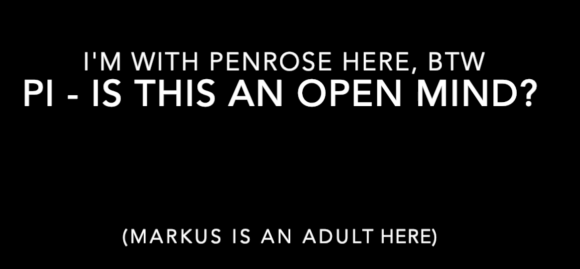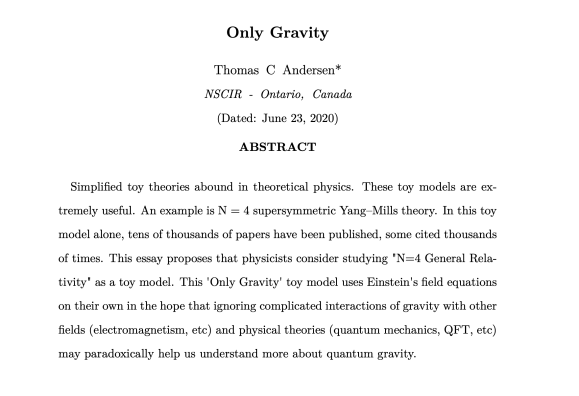Qingdi Wang, Zhen Zhu, and William G. Unruh
It (I will call the paper WZU) has been discussed at several places:
Sabine Hossenfelder at the Backreaction blog,
Reddit ,
So why talk about it more here?
Well because its an interesting paper, and I think that many of the most interesting bits have been ignored or misunderstood (I’m talking here about actual physicists not the popular press articles).
For instance here are two paragraphs from Sabine Hossenfelder
Another troublesome feature of their idea is that the scale-factor of the oscillating space-time crosses zero in each cycle so that the space-time volume also goes to zero and the metric structure breaks down. I have no idea what that even means. I’d be willing to ignore this issue if the rest was working fine, but seeing that it doesn’t, it just adds to my misgivings.
So with the first paragraph, Sabine is talking about the a(t, x) factor in the metric (see equation 23 in the paper). I think that she could be a little more up front here: a(t, x) goes to zero alright, but only in very small regions of space for very short times (I’ll come back to that later). So in reality the average of the a(t,x) over any distance/time Planck scale or larger determines an almost flat, almost Lambda free universe -> average(a(t,x)) –> the a(t) as per a FLRW metric. I guess Sabine is worried about those instants when there are singularities in the solution. I agree with the answer to this supplied in the paper:
It is natural for a harmonic os- cillator to pass its equilibrium point a(t,x) = 0 at maximum speed without stopping. So in our solution, the singularity immediately disappears after it forms and the spacetime continues to evolve without stopping. Singularities just serve as the turning points at which the space switches. ...(technical argument which is not all that complicated)... In this sense, we argue that our spacetime with singularities due to the metric becoming degenerate (a = 0) is a legitimate solution of GR.
As I said, more on that below when we get to my take on this paper.
The second paragraph above from the Backreaction blog concerns the fact that the paper authors used semi classical gravity to derive this result.
The other major problem with their approach is that the limit they work in doesn’t make sense to begin with. They are using classical gravity coupled to the expectation values of the quantum field theory, a mixture known as ‘semi-classical gravity’ in which gravity is not quantized. This approximation, however, is known to break down when the fluctuations in the energy-momentum tensor get large compared to its absolute value, which is the very case they study.
They are NOT using a classical gravity coupled to the expectation values of the quantum field theory. Indeed, according to WZU and the mathematics of the paper they say:
In this paper, we are not trying to quantize gravity. Instead, we are still keeping the spacetime metric a(t, x) as classical, but quantizing the fields propagating on it. The key difference from the usual semiclassical gravity is that we go one more step—instead of assuming the semiclassical Einstein equation, where the curvature of the spacetime is sourced by the expectation value of the quantum field stress energy tensor, we also take the huge fluctuations of the stress energy tensor into account. In our method, the sources of gravity are stochastic classical fields whose stochastic properties are determined by their quantum fluctuations.
So I think that she has it wrong. In her reply to my comment on here blog she states that its still semiclassical gravity as they use the expectation values of the fluctuations (they don’t as you can see by the quote above or better by looking at the paper. See how the equation 29 talks about expectation values, but the actual solution does not use them ). She concludes her comment: “Either way you put it, gravity isn’t quantized.” I think that’s also fair appraisal of the attitude of many people on reading this paper many people don’t like it because gravity is treated classically.
Why I think the paper is interesting.
Gravity is not quantized: get over it
I think its interesting as their approach to connecting gravity to the quantum world is basically identical to my Fully Classical Quantum Gravity experimental proposal – namely that gravity is not quantized at all and that gravity couples directly to the sub-quantum fluctuations. Wang and co-authors apologize for the lack of a quantum theory of gravity, but that appears to me anyway as more of a consensus-towing statement than physics. Indeed, the way its shoved in at the start of section C seems like it is an afterthought.
(Gravitational) Singularities are no big deal
Singularities are predicted by many or (even all?) field theories in physics. In QED the technique of renormalization works to remove singularities (which are the same as infinities). In the rest of modern QFT singularities are only perhaps removed by renormalization. In other words quantum field theory blows up all by itself, without any help from other theories. Its naturally bad.
The Einstein equations have a different behaviour under singular conditions. They are completely well behaved. Its only when other fields are brought in, such as electromagnetism or quantum field theory that trouble starts. But all on their own singularities are no big deal in gravity.
So I don’t worry about the microscopic, extremely short lived singularities in WZU at all.
Why it’s exciting
We have WZU metric equation 23
ds2 = −dt2 +a2(t,x)(dx2 +dy2 +dz2)
a(t,x) oscillates THROUGH zero to negative, but the metric depend on a^2, so we have a positive definite metric that has some zeros. These zeros are spread out quasi periodically in space and time. If one takes two points on the manifold (Alice and Bob denoted A & B), then the distance between A and B will be equivalent to the flat space measure (I am not looking at the A and B being cosmic scale distances apart in time or space, so its almost Minkowski). Thus imagine A and B being 1 thousand km apart. The scale factor a(t, x) averages to 1.
Here is the exciting bit. While an arbitrary line (or the average of an ensemble of routes) from A -> B is measured as a thousand km, there are shorter routes through the metric. Much shorter routes. How short? Perhaps arbitrarily short. It may be that there is a vanishingly small set of paths with length ds = 0, and some number of paths with ds just greater than 0, all the way up to ‘slow paths’ that spend more time in a > 1 areas.
Imagine a thread like singularity (like a cosmic string – or better a singularity not unlike a Kerr singularity where a >> m). In general relativity such a thread is of thickness 0, and the ergo region around it also tends to zero volume. One calculation of the tension on such a gravitational singularity ‘thread’ (I use the term thread as to not get confused with string theory) come out to a value of about 0.1 Newtons. A Newton of tension on something so thin is incredible. Such a thread immersed in the WZU background will find shorter paths – paths that spend more time in areas where a << 1, these paths being much more energetically favoured. There are also very interesting effects when such gravitational thread singularities are dragged through the WZU background. I think that this might be the mechanism that creates enough action to generate electromagnetism from pure general relativity only.

A 2D slice at some time through ordinary WZU vacuum. The spots are places where a~2. The straight line from A to B has an average scale factor a of 1, while the wiggly path follows a ~ 0 and hence has an average scale factor of << 1. Note that these short paths are not unique, and there is little constraint for them to be even approximately straight.
So these thread singularities thread their way through the frothy WZU metric and as such the distance a single such thread may measure between Alice and Bob may be far far less than the flat space equivalent.
It seems to me that one could integrate the metric as given in WZU equation 23 with a shortest path condition and come up with something. Here is one possible numerical way: start out with a straight thread from A to B. Then relax the straight line constraint, assign a tension to the thread, and see what the length of the thread after a few thousand iterations, where at each iteration, each segment allows itself to move toward a lower energy state (i.e. thread contraction).
This opens up:
Quantum non-locality
Realist, local quantum mechanics is usually thought of requiring on having some dependency on non-local connections, as quantum experiments have shown. This shortcut path may be an answer to the need for non-local connections between particles, i.e. a mechanism for entaglement, a mechanism for Einstein’s “spooky action at a distance”.
Faster than light communication.
Its always fun to see if there are realistic methods where one might beat the speed limit on light. It seems that worm hole traversal has been one of the favourites to date. I think that the WZU paper points at another mechanism – the fact that there exist shorter paths through the sub-quantum general relativistic froth of WZU. How might one construct a radio to do this? Entangled particles, particles that follow the zeros of a(t, x) preferentially, etc etc. One could imagine a brute force method to test this where huge pulses of energy are transmitted through space at random intervals. Perhaps a precursor signal could be measured at the detector, where some of the energy takes a short path through the WZU metric.





 Andersen, T. C. on ORCID
Andersen, T. C. on ORCID



